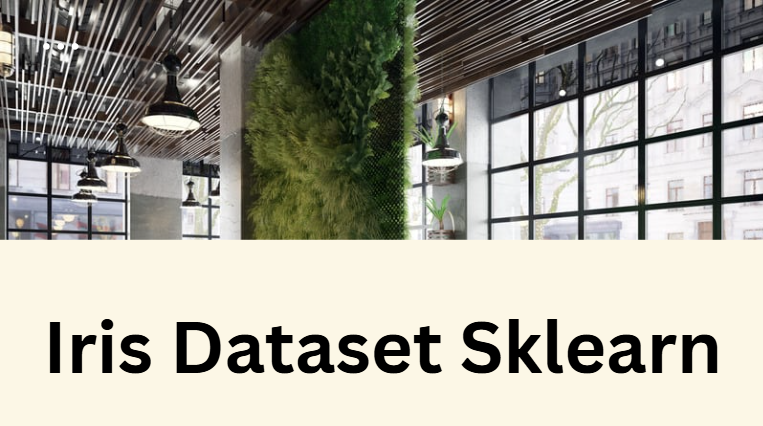The Iris dataset is one of the most famous datasets in the world of machine learning. It is included in Scikit-Learn (sklearn), a popular Python library used for data science. Many beginners start learning classification by using this dataset because it is clean, small, and very easy to understand.
In this article, we will learn what this dataset is, why it is famous, how to load it in sklearn, and how we can use it for a basic machine learning model.
1. What is the Iris Dataset?
The Iris dataset was first introduced by a British statistician Ronald Fisher in 1936. It includes information about 150 iris flowers from 3 different species:
✅ Iris Setosa
✅ Iris Versicolor
✅ Iris Virginica
Each flower has four features:
Feature NameWhat It MeansSepal LengthLength of outer part of flowerSepal WidthWidth of outer partPetal LengthLength of inner petalPetal WidthWidth of inner petal
These features help the computer decide which species a flower belongs to.
2. Why is the Iris Dataset So Popular?
Here are the main reasons:
- 🌱 Small size – only 150 rows
- 🎯 Clear labels – 3 simple classes
- 📏 Numeric features – easy to use in algorithms
- 🧹 Clean data – no missing values
- 🎓 Great for learning classification
Because of these benefits, beginners can focus on learning machine learning instead of cleaning messy data.
3. Loading the Iris Dataset in sklearn
Sklearn makes the dataset very easy to load. You just need a few lines of code:
from sklearn.datasets import load_iris iris = load_iris() X = iris.data y = iris.target
- X contains the four features
- y contains the flower type (0, 1, 2)
You can also explore the data using:
print(iris.feature_names) print(iris.target_names) print(iris.data[:5])
This will show the feature names, species names, and first few rows.
4. Visualizing the Iris Dataset
To understand the data more clearly, people often draw charts such as:
- Scatter plots
- Pair plots
- Histograms
Example using matplotlib:
import matplotlib.pyplot as plt plt.scatter(X[:, 0], X[:, 1], c=y) plt.xlabel(‘Sepal Length’) plt.ylabel(‘Sepal Width’) plt.title(‘Iris Dataset Scatter Plot’) plt.show()
Each flower species will appear as a different color in the graph.
5. Building a Simple Classifier
Machine learning models learn the relationship between features and labels.
Here is a simple model using Decision Tree Classifier:
from sklearn.model_selection import train_test_split from sklearn.tree import DecisionTreeClassifier from sklearn.metrics import accuracy_score X_train, X_test, y_train, y_test = train_test_split(X, y, test_size=0.3, random_state=42) model = DecisionTreeClassifier() model.fit(X_train, y_train) predictions = model.predict(X_test) print(“Accuracy:”, accuracy_score(y_test, predictions))
This model usually gives very high accuracy (above 90%) because the data is well-separated.
6. Train-Test Split Importance
Machine learning needs testing to check how well the model performs on new data.
That’s why we split data:
- Training data: teaches the model
- Testing data: checks the performance
Using a test size of 30% is very common.
7. Applications of Iris Dataset Learning
Learning with this dataset helps beginners do:
- ✅ Multi-class classification
- ✅ Data visualization
- ✅ Feature understanding
- ✅ Testing algorithms like:
- K-Nearest Neighbors (KNN)
- Decision Trees
- Logistic Regression
- SVM (Support Vector Machines)
It builds confidence to move to bigger and real-world datasets.
8. Limitations of Iris Dataset
Even though it is great for learning, it has limits:
⚠️ Only 150 samples — too small for real-world problems
⚠️ Only 4 features — not complex enough
⚠️ Very clean — does not teach data cleaning skills
So it is perfect for practice, but not for production projects.
9. Summary
TopicShort AnswerWhat is it?A flower dataset with 150 samplesHow many species?3 classesHow many features?4 numeric featuresWhere to find?Built inside sklearnBest use?Learning classification basics
The Iris dataset is like a first step in the machine learning journey.
Once you master it, you can explore large and real-life datasets with confidence.
FAQs
Q1: Is the Iris dataset free to use?
Yes. It is included in sklearn and free for everyone.
Q2: Can beginners use it?
Absolutely! It is specially used for beginners.
Q3: How many labels does the dataset have?
Three different flower species.
Q4: Can we use deep learning with the Iris dataset?
You can, but it is not recommended because the data is too small.
Q5: What is the most common algorithm used?
Decision Tree, KNN, and Logistic Regression are very popular starting points.

